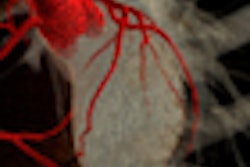Early clinical results with a digital radiography (DR)-based tomosynthesis system indicate that it outperforms conventional digital x-ray in detecting pulmonary nodules. Duke University researchers found that tomosynthesis had triple the sensitivity of standard DR for detecting nodules large enough to require further diagnostic workup.
Digital tomosynthesis systems consist of a standard DR system, with the addition of a motorized gantry capable of moving in an arc in front of the patient. The system captures a series of low-dose exposures during a single sweep, and the acquired images are processed into slices that show anatomical structures at different depths and angles. Digital tomosynthesis proponents believe the technology can counteract the effects of overlapping structures that can obscure pathology on conventional radiography.
A research group led by Dr. James Dobbins from Duke University in Durham, NC, has been in the forefront of research with radiography tomosynthesis. The group's current study, supported with funding from the U.S. National Institutes of Health (NIH), includes some of the first results from studies of human subjects with a prototype digital tomosynthesis system. Their research was published in the June issue of Medical Physics (June 2008, Vol. 35:6, pp. 2554-2557).
The group examined 21 patients with a prototype digital tomosynthesis unit developed at the university. Study subjects consisted of patients returning for follow-up CT evaluation of known lung nodules 3-15 mm in diameter.
Patients received both the medically indicated CT scan, as well as a posterior-anterior (PA)/lateral chest x-ray on a conventional DR system (Revolution XQ/i, GE Healthcare, Chalfont St. Giles, U.K.). (Only the PA images were used for data analysis in the study.) The tomosynthesis images were then acquired with the prototype system.
The standard tomosynthesis image acquisition protocol was to collect 71 projection images at 5 mm of plane spacing for reconstruction, for a total of 20° of tube angular motion. The total scan took 11 seconds to complete, easily within the time period of a human breath-hold. The system used a commercial-grade cesium iodide amorphous silicon flat-panel detector, equivalent to the Revolution XQ/i system.
According to the researchers, total patient radiation exposure for the tomosynthesis images was equivalent to 11 PA radiographs (about equal to a conventional film-screen lateral x-ray or two DR lateral exams), for a total exposure from tomosynthesis of 68-135 mR.
The CT images were reviewed by two chest radiologists, with this data regarded as the "truth" set regarding the presence of nodules. Three chest radiologists then independently reviewed the tomosynthesis images and, after two weeks, the PA radiographs from the conventional DR system.
The readers knew the location of each target nodule based on the CT scans, and they assessed whether a nodule was visible at that location on the tomosynthesis and PA images. They graded visibility as "definitely visible," "uncertain," or "not visible." Nodules were also grouped by size.
A total of 175 nodules greater than or equal to 3 mm were found in the 21 patients, with the number of nodules per patient ranging from one to 22. The smallest nodule was 3.5 mm in diameter, while the largest was 25.5 mm. The mean diameter of all nodules was 7.3 mm.
The authors noted that nodules were much more visible on digital tomosynthesis images as opposed to the PA images acquired on the conventional DR system at all sizes (p = 0.004). Sensitivity results are shown in the table below, classified by nodule size.
Sensitivity of digital tomosynthesis versus PA DR
|
Tomosynthesis performed well for lesions smaller than 5 mm, an area where conventional radiography has traditionally fallen short. Lesions smaller than 4 mm do not require further diagnostic workup, according to the criteria of the Fleischner Society for Thoracic Imaging and Diagnosis.
"Tomosynthesis extends the detection limit to substantially smaller nodules than PA radiography," Dobbins and colleagues wrote. "Considering only the nodules that would be actionable by the criteria endorsed by the Fleischner Society (> 4 mm in diameter), 74% were visible in the tomosynthesis images compared with 25% in the PA radiographs, indicating a threefold increase in detection sensitivity."
The authors acknowledged several drawbacks to their study, in particular the "somewhat artificial" reading paradigm in which radiologists knew the exact location of nodules before they began reading the images. They felt this probably resulted in an overestimation of the sensitivity of both tomosynthesis and PA radiography, but because the sensitivity difference between the two technologies was so wide, they felt tomosynthesis would continue to maintain a large advantage under more realistic conditions.
The current study also did not evaluate specificity, but the authors said that this data would be available at the conclusion of the current NIH-sponsored trial.
By Brian Casey
AuntMinnie.com staff writer
August 11, 2008
Related Reading
TMJ imaging benefits from digital tomo technique, December 24, 2007
DR pumps new life into tomosynthesis-based radiography, October 29, 2007
Duke researchers combine DR tomosynthesis with 3D CAD, June 4, 2007
Copyright © 2008 AuntMinnie.com



















